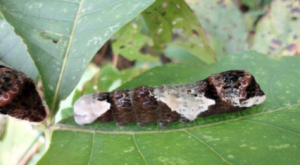Recently, one of the items covered by the news media was the change in distribution of various species owing to climate change. There are other causes for expansions of populations other than climate shifts but this discussion is limited to the global warming phenomenon. The media accounts included the recent appearance of fish species in the ocean much further north than where they normally occur. One species that was mentioned that has relevance to our own area was the Giant Swallowtail Butterfly.

While it is a good thing that the media covered this important story, they unfortunately got it wrong. To listen to what they were saying one was left with the impression the species involved were fleeing from excessive heat in their traditional areas and seeking respite in cooler areas. This is not the case. The geographic range expansion is possible only because the new areas are now offering conditions (slightly warmer) where the cooler conditions had prevented then from surviving before. Giant Swallowtails (Papilio cresphontes) are the largest butterfly in much of North America. Their wingspan ranges from 10 to 14 cm across! (Figure 1). They tend to stay in woodland areas or, in the southern US, in citrus groves. The adults sip flower nectar for food. The larvae of this butterfly are known as the ‘Orange Dog’, not for their colour but for their host in citrus groves. The caterpillars look a lot like bird droppings and can get as big as 4.5 cm long! (Figure 2)
They generally adopt a disguise by looking like bird droppings, an appearance that they retain until they pupate. Another deterrent to would-be predators is the osmeterium. This is a reddish, forked gland located behind the head that is extended when the caterpillar disturbed. The osmeterium exudes a fluid that is considered to smell terrible and deters any attacker.

In years past, Giant Swallowtails were essentially restricted to the far southern parts of the province. They would occasionally wander farther and one vagrant had been reported at Ottawa. Now they are much more frequent in parts of the province where they were seen only occasionally. How much of this recent range expansion is due to climate change is still unclear. Milder winters could certainly assist in the survival of the species over the coldest part of the year. A key limitation in their distribution is the availability of their host plants.
Hosts of the Giant Swallowtail all belong to the citrus plant family Rutaceae. We do not have many groves of oranges or lemons in Ontario to sustain the butterflies but we do have a few other members of the plant family. The list includes Gas Plant (Dictamnus albus), Cork Tree (Phellodendron amurense), Common Rue (Ruta graveolens), Common Hop-tree (Ptelea trifoliata) and American Prickly-ash (Zanthoxylum americanum). The first three mentioned are all introduced or non-native species. They are rarely grown and are thus hardly capable of sustaining populations of the butterflies in Ontario. The Hop-tree is rather uncommon in Ontario and restricted to the Carolinian zone. The main job of supporting the larvae of the Giant Swallowtails then falls to the Prickly-ash that has a much wider distribution than the others though it also tends to grow in more southern parts of the province. Prickly-ash is a relatively inconspicuous species that goes unnoticed unless one needs to cross through a patch of it. Then the thorns on its stems are more than adequate to grab the traveler’s attention. Other than vagrant butterflies that might be carried by the wind, the anticipated range of the butterflies is going to strongly mirror the distribution of Prickly-ash. Perhaps the changing climate will allow that plant to extend its range and thus allow the butterflies to follow further a field. It will be interesting to follow shifts in distribution patterns for these species as well as others that exhibit similar types of range restrictions.
by W.D. McIlveen
Halton/North Peel Naturalist Club
